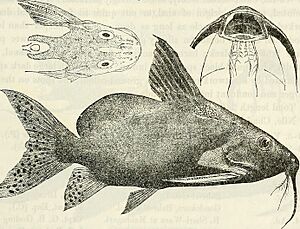Synodontis membranaceus facts for kids
Quick facts for kids Synodontis membranaceus |
|
|---|---|
 |
|
| Conservation status | |
| Scientific classification | |
| Genus: |
Synodontis
|
| Species: |
membranaceus
|
| Synonyms | |
|
|
The Synodontis membranaceus, also known as the moustache catfish, is a cool type of upside-down catfish. It lives in the waters of northern Africa. A French scientist named Geoffroy Saint-Hilaire first described this fish in 1809. He found it in the famous Nile River. The name membranaceus means "having membranes." This refers to the special skin flaps on the fish's whiskers, called barbels.
Contents
About the Moustache Catfish
Like all fish in the Synodontis family, the moustache catfish has a strong, bony head. This head covering goes all the way back to its first top fin spine. It also has a unique bony bump on its head called a humeral process. The shape and size of this bump help scientists tell different Synodontis species apart. For the moustache catfish, this bump is flat and rough. It is shaped like a triangle and is about as long as it is deep.
Whiskers and Fins
This fish has three pairs of barbels, which are like whiskers. One pair is on its upper jaw, and two pairs are on its lower jaw. The upper whiskers are straight and have a wide skin flap along most of their length. They are about as long as the fish's head. The inner pair of lower whiskers is shorter than the outer pair. These inner whiskers have thin branches and also a skin flap on their outer half.
The front edges of the top fin (dorsal fin) and side fins (pectoral fins) of Synodontis fish are stiff spines. In the moustache catfish, the top fin spine is quite long, about three-fifths to four-fifths the length of its head. This spine can be straight or curved. It is smooth on the front but has jagged edges on the back. The rest of the top fin has seven soft, branching rays. The side fin spine is about the same length as the top fin spine. It has jagged edges on both sides.
The fish also has a small, fleshy fin called an adipose fin. This fin is much longer than it is deep. Its bottom fin (anal fin) has five unbranched rays and eight or nine branched rays. This fin is sharply pointed. The tail fin is deeply split, looking like a fork.
Teeth and Color
All Synodontis fish have a special pad of teeth on the very front of their upper jaw. This pad has several rows of short, chisel-shaped teeth. In the moustache catfish, this tooth pad is short and narrow. On its lower jaw, the teeth are attached to flexible, stalk-like structures. These teeth are often described as "s-shaped" or "hooked." Scientists count these lower jaw teeth to tell species apart. The moustache catfish usually has about 8 to 14 small teeth on its lower jaw.
The color of the moustache catfish is silvery grey or whitish on its back and sides. However, its belly and lower parts are dark brown to black. Its whiskers are whitish, but the skin flaps on them have a dark brown or black border. Young fish might have faint dark spots on their bodies. They can also have spots on their fins that look like stripes, but these fade as the fish gets older.
This fish can grow up to about 46 centimeters (18 inches) long. Generally, female Synodontis fish tend to be a bit larger than males of the same age.
Habitat and Life Cycle
In the wild, the moustache catfish lives in an area stretching from Senegal to Sudan. People in these regions sometimes catch this fish for food. It naturally lives in the deep parts of streams, usually close to the shore.
Unique Behavior
One interesting thing about this fish is that it often swims upside down in the wild! Its belly faces upward. This explains why its underside is darker and its back is lighter. This color pattern helps it blend in when swimming upside down. However, if you keep this fish in an aquarium, it sometimes stops swimming upside down. When that happens, its color pattern can change, so its back becomes dark and its belly becomes light.
What They Eat
In their natural home, moustache catfish eat a variety of things. They feed on tiny living things called plankton. They also eat dead plant and animal matter (detritus), insects, small crustaceans, and mollusks (like snails).
Reproduction
Scientists don't know a lot about how most Synodontis species reproduce. We do know that female fish can carry many eggs. They likely lay their eggs during the rainy season, usually between July and October. Pairs of fish swim together when they lay eggs. Young fish grow very quickly during their first year. After that, their growth slows down as they get older.


